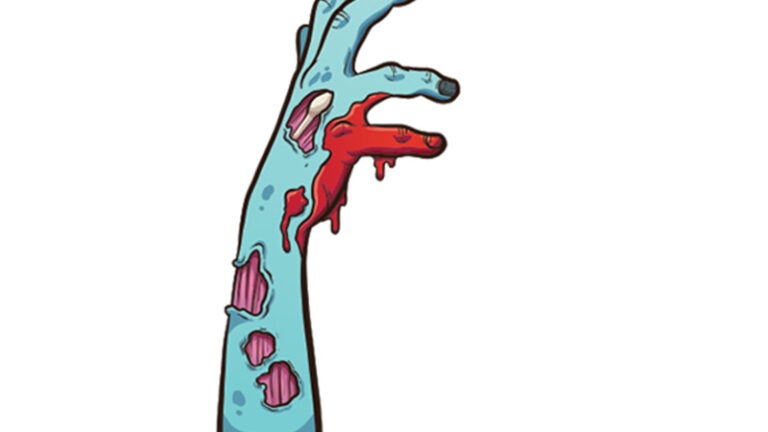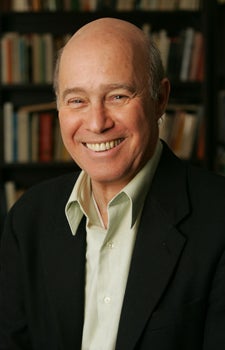
Scary Monsters and Super Creeps
Almost 35 years have passed since a ragtag troupe of gyrating zombies first captivated audiences worldwide, helping to propel Michael Jackson’s 1983 hit “Thriller” to the coveted position of greatest music video of all time. Our appetite for all things associated with the undead has only grown more pronounced since.
World War Z, The Twilight Saga, The Walking Dead, True Blood, the White Walkers from Game of Thrones — our current obsession with monsters seems to be at an all-time high as we binge on a raft of popular movies and TV series dedicated to vampires and zombies. In today’s youth-obsessed culture in which we are reluctant to even acknowledge our own mortality, much less discuss it, does this fascination with monsters signal a need to confront our fear of death?
First, there is nothing new in our love of monsters, notes Leo Braudy, University Professor and Leo S. Bing Chair in English and American Literature. “We have told each other scary stories since the beginning of time. Ghosts, for instance, have been around since the start of civilization,” he said.
Braudy, professor of English, art history, film and history, is a monster expert and the author of Haunted: On Ghosts, Witches, Vampires, Zombies, and Other Monsters of the Natural and Supernatural Worlds (Yale University Press, 2016).
Our fascination with monsters, he says, begins in childhood with the fairy tales we hear at our mother’s knee.
“Children love fairy tales for the same reasons we all love frightening stories — because they allow us a kind of mastery,” he said. “They’re comforting, but also titillating, certainly for adults. It’s that idea of ‘you escaped.’ ”
Recognizing the four categories of monsters
In Haunted, Braudy divides monsters into four categories. First, “the monster from nature” embodies our fear of an uncontrollable natural world. Examples fall into two groups: mysterious, elusive but ultimately less threatening monsters like Sasquatch, the Yeti or the Loch Ness Monster; and more menacing specimens, like Godzilla or King Kong, that embody the fear that nature will take her revenge for our transgressions against her.
“What horror does,” Braudy said, “is keep our mortality squarely in front of us.”The second type of monster is associated with the fear of science. Frankenstein is an example of this kind of monster, created purposefully by a scientist whose hubris leads him to believe he can rival God’s creativity to bring to life an unprecedented being.
Third, comes the Jekyll and Hyde monster. Appearing in the late 1880s, it is one of several doppelganger figures — people with double lives or double selves — that reflects the more complex, late Victorian view of human psychology. This is rendered not necessarily in terms of Freudian psychoanalysis or depth psychology, but in terms of fears of the monstrousness of one’s otherwise repressed self. This psychological monster-from-within nevertheless coincides with Freud’s early development of his theories of psychology and the inner self.
Finally, there is the monster from the past that arrives to take revenge on us and our modern cult of progress, improvement and change.

“Dracula, who comes out of a very distant, even pre-Christian past, is a prime example,” Braudy noted. “He promises immortality.”
Vampires and zombies
Our modern-day enthusiasm for vampires stems from our desire to avoid confronting our own mortality, Braudy believes. “Vampires have lived for thousands of years, have survived history, so they are simultaneously feared but admired, because they represent, for the moment, a liberation from mortality.”
On the other hand, the current zombie craze, Braudy argues, reflects our present-day fear of groups. This is an era where we’re less afraid of James Bond-type villains — those descendants of Hitler and Mussolini who want to rule the world — and more afraid of the faceless, shadowy, anonymous groups we can’t pin down.
“What’s really different about the zombie and what separates it from most of the classic monsters is that it’s part of a collective, while other monsters are individuals,” Braudy said. “There’s no hierarchy in the zombie world, no ‘king zombie,’ so fear of zombies represents a modern fear of groups. They might be Islamic fundamentalists, immigrants, Republicans, Democrats — you name it, whatever group frightens you.”
A revealing obsession
Our love of monsters is revealing, Braudy argues, showing us how preoccupied we are with death and mortality. Our obsession with monsters provides the counterbalance to our own change in funerary practices as described in Jessica Mitford’s celebrated book The American Way of Death — medicalized, sanitized death that now takes place mostly in hospitals, far removed from our daily lives.
“What horror does,” Braudy said, “is keep our mortality squarely in front of us.”
Popular culture, he argues, essentially allows us to indulge our fears and desires without penalty, and that explains the pleasure we currently derive from watching films or TV shows featuring monsters, including zombies and vampires.
“Popular culture is, to a certain extent, emotionally compensatory,” Braudy said. “It allows us to indulge those fears and desires that medical science has deprived us of by de-sentimentalizing or de-emotionalizing death.”
“Scary monsters, super creeps / keep me running, running scared,” David Bowie sang on his hit from the 1980 Scary Monsters (And Super Creeps) album. His words still ring true today and, according to Braudy, will likely continue to do so for generations to come. “Our fascination with monsters,” Braudy said, “is perpetual.”
Read more stories from USC Dornsife Magazine’s Fall 2017-Winter 2018 issue